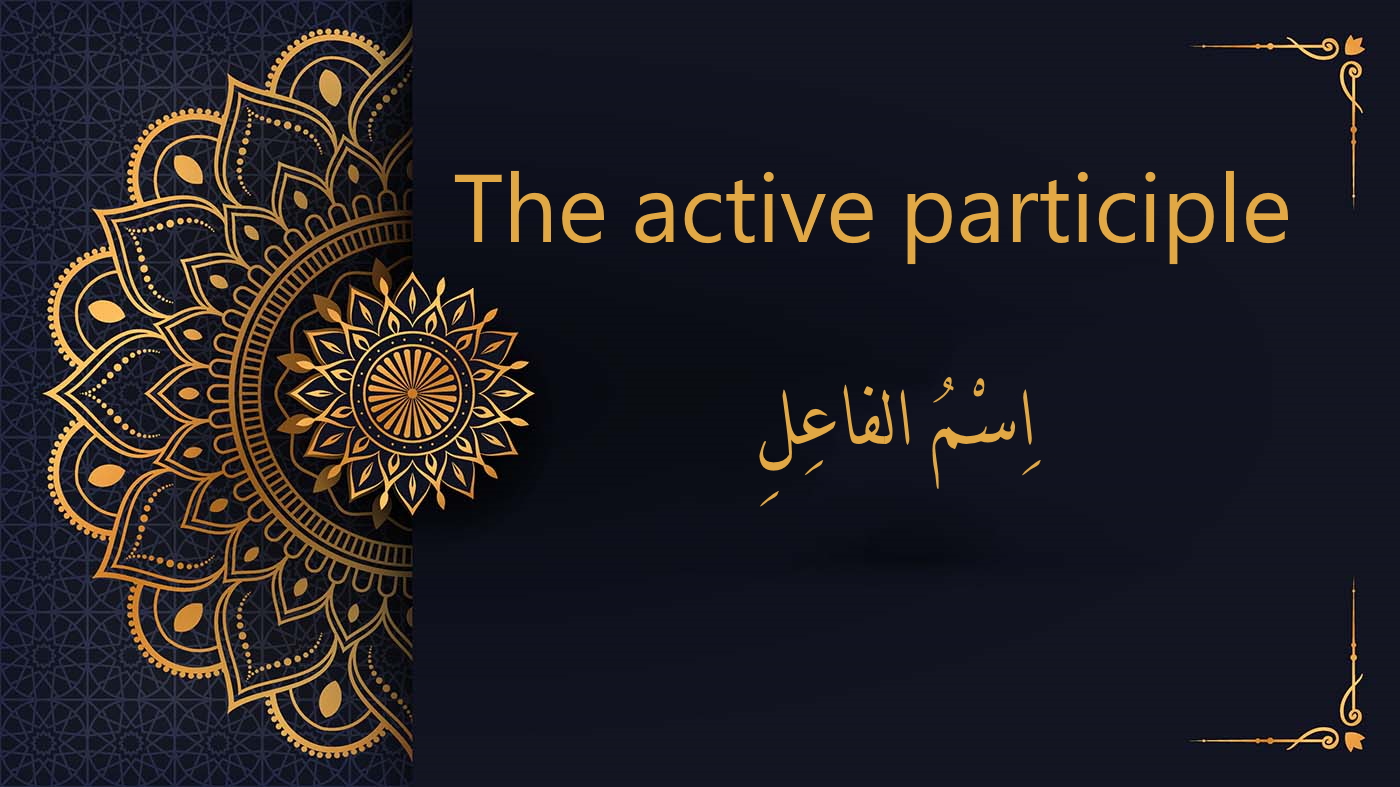
Active participle in Arabic - اِسْمُ الفاعِل
1. Introduction
In Arabic grammar, the term for the noun representing the doer of an action, also known as the subject, is “اسم الفاعل” or the active participle. It is constructed by adding an alif (ا) to the first radical of the verb (فعل), providing the middle letter with a kasrah (ِ), and the last radical with a tanween. This results in the active participle pattern: “فاعلٌ.
Example:
سَجَدَ / سَاجِدٌ
one who prostrates / to prostrate
حَمِدَ / حَامِدٌ
one who praises / to praise
كَفَرَ / كَافِرٌ
A disbeliever / to disbelieve
Masculine Gender Active Participle Table
Nominative case – حَالَةُ الرَّفَعِ
Singular
فَاعِلٌ
A doer
Dual
فَاعِلانِ
Two doers
Plural
فَاعِلُوْنَ
Doers
Accusative – حَالَةُ النَصَبِ
Singular
فَاعِلًا
A doer
Dual
فَاعِلَيْنِ
Two doers
Plural
فَاعِلَيْنِ
Doers
Genitive – حَالَةُ الجَرِّ
Singular
فَاعِلٍ
A doer
Dual
فَاعِلَيْنِ
Two doers
Plural
فَاعِلَيْنِ
Doers
Feminine Gender Active Participle Table
Nominative case – حَالَةُ الرَّفَعِ
Singular
فَاعِلَةٌ
A doer
Dual
فَاعِلَتَانِ
Two doers
Plural
فَاعِلاتٌ
Doers
Accusative – حَالَةُ النَصَبِ
Singular
فَاعِلَةً
A doer
Dual
فَاعِلَتَيْن
Two doers
Plural
فَاعِلات
Doers
Genitive – حَالَةُ الجَرِّ
Singular
فَاعِلَةٍ
A doer
Dual
فَاعِلَتَيْن
Two doers
Plural
فَاعِلات
Doers
Examples of Active Participles in the Holy Quran
قُلْ يَا أَيُّهَا الْكَافِرُونَ
Say, “O disbelievers, (109:1)
وَلَا أَنَا عَابِدٌ مَّا عَبَدتُّمْ
Nor will I be a worshipper of what you worship. (109:4)
وَلَا أَنتُمْ عَابِدُونَ مَا أَعْبُدُ
Nor will you be worshippers of what I worship. (109:5)
فَيُصْبِحُوا عَلَىٰ مَا أَسَرُّوا فِي أَنفُسِهِمْ نَادِمِينَ
and they will become, over what they have been concealing within themselves, regretful. (5:52)
وَلَهُمْ فِيهَا أَزْوَاجٌ مُّطَهَّرَةٌ ۖ وَهُمْ فِيهَا خَالِدُونَ
And they will have therein purified spouses, and they will abide therein eternally. (2:25)
2. Hamzated and assimilated verb
Hamzated and assimilated verbs, such as أَكَلَ – سَأَلَ, قَرَأَ, وَعَدَ, and يَسِرَ, form their active participles using the pattern of فَاعِلٌ.
Examples:
أَكَلَ / آكِلٌ
One who eats
سَأَلَ / سَائِلٌ
Questioner
قَرَأَ / قَارِئٌ
One who reads
وَعَدَ / وَاعِدٌ
One who promises
يَسِرَ / يَاسِرٌ
One who becomes easy
Examples:
سَأَلَ سَائِلٌ بِعَذَابٍ وَاقِعٍ
A supplicant asked for a punishment bound to happen (70:1)
Certain active participles follow the pattern of فَعِيْلٌ. These participles are often used as adjectives to describe eternal and everlasting qualities.
Example:
عَظِيْكٌ – Great one
حَسِيْنٌ – Good one
كَبِيْرٌ – Big one
قَالَ فَاخْرُجْ مِنْهَا فَإِنَّكَ رَجِيمٌ
[Allah] said, “Then get out of it, for indeed, you are expelled. (15:34)
إِنْ هَـٰذَا إِلَّا مَلَكٌ كَرِيمٌ
this is none but a noble angel.” (12:31)
الرَّحْمَـٰنِ الرَّحِيمِ
The Entirely Merciful, the Especially Merciful, (1:3)
3. Hollow verbs
When the second radical in a verb is the weak letter و or ى, the corresponding active participle will follow the pattern of فَاعِلٌ
Examples:
قَالَ / قَائِلٌ
one who speaks
بَاغَ / بائِغٌ
One who sells
4. Defective verbs
When the third radical is the weak letter و or ى, as in verbs like دَعَا and رَمَى, the active participle will follow the pattern of دَاعِوٌ and دَامِوٌ, which is consistent with the فَاعِلٌ pattern. However, there is a notable change in its formation.
دَعَا = دَاعِوٌ – دَاعٍ
One who calls
رَمَى = رامِوُ – رامٍ
One who throws
لَقِيَ = لاقِوٌ – لاقٍ
One who meets
This occurs because when و or ى bear dammah tanween and are preceded by kasrah, they are dropped, and the vowel of the preceding letter changes to tanween kasrah (ِ).
Active Participle Table for Masculine Gender - دَاعٍ (Da'in):
Nominative case – حَالَةُ الرَّفَعِ
Singular
دَاعٍ
A caller
Dual
دَاعِيَانِ
Two caller
Plural
دَاعُوْنَ
Callers
Accusative – حَالَةُ النَصَبِ
Singular
دَاعِيًا
A caller
Dual
دَاعِيَيْنِ
Two caller
Plural
دَاعِيْنَ
Callers
Genitive – حَالَةُ الجَرِّ
Singular
دَاعٍ
A caller
Dual
دَاعِيَيْنِ
Two caller
Plural
دَاعِيْنَ
Callers
Active Participle Table for Feminine Gender - دَاعٍ (Da'in):
Nominative case – حَالَةُ الرَّفَعِ
Singular
دَاعِيَةٌ
A caller
Dual
دَاعِيَتَانِ
Two caller
Plural
دَاعِيَاتٌ
Callers
Accusative – حَالَةُ النَصَبِ
Singular
دَاعِيَةً
A caller
Dual
دَاعِيَتَيْنِ
Two caller
Plural
دَاعِيَاتٍ
Callers
Genitive – حَالَةُ الجَرِّ
Singular
دَاعِيَةٍ
A caller
Dual
دَاعِيَتَيْنِ
Two caller
Plural
دَاعِيَاتٍ
Callers
When “الْ” is added to the singular of active participles like “دَاعٍ,” the “ى” will be written as “الدَّاعِي.
5. Double lettered verbs - الْمُضاعَفُ
According to the pattern “فَاعِلٌ,” the active participle of verbs on the pattern of “ظَنَّ” should be “ظَانِنٌ.” However, they are written with a shaddah -ّ as “ظَآنٌّ.
Examples:
ظَنَّ =ظَانِنٌ – ظَآنٌّ
One who suspects.
ضَلَّ = ضّالِلٌ – ضَالٌّ
One who goes astray
صِرَاطَ الَّذِينَ أَنْعَمْتَ عَلَيْهِمْ غَيْرِ الْمَغْضُوبِ عَلَيْهِمْ وَلَا الضَّالِّينَ
The path of those upon whom You have bestowed favor, not of those who have evoked [Your] anger or of those who are astray. (1:7)
Active Participle Table for Masculine Gender - ظَنَّ
Nominative case – حَالَةُ الرَّفَعِ
Singular
ظَآنٌّ
One who suspects
Dual
ظَآنَّانِ
Those two who suspects
Plural
ظَآنُّوْنَ
Those who suspect
Accusative – حَالَةُ النَصَبِ
Singular
ظَآنَّا
One who suspects
Dual
ظَآنَّيْنِ
Those two who suspects
Plural
ظَآنَّيْنَ
Those who suspect
Genitive – حَالَةُ الجَرِّ
Singular
ظَآنٍّ
One who suspects
Dual
ظَآنَّيْنِ
Those two who suspects
Plural
ظَآنَّيْنَ
Those who suspect
Active Participle Table for Feminine Gender - ظَنَّ
Nominative case – حَالَةُ الرَّفَعِ
Singular
ظَآنَّةٌ
One who suspects
Dual
ظَآنَّتَانِ
Those two who suspects
Plural
ظَآنَّاتٌ
Those who suspect
Accusative – حَالَةُ النَصَبِ
Singular
ظَآنَّةً
One who suspects
Dual
ظَآنَّتَانِ
Those two who suspects
Plural
ظَآنَّاتٌ
Those who suspect
Genitive – حَالَةُ الجَرِّ
Singular
ظَآنَّةٍ
One who suspects
Dual
ظَآنَّتَانِ
Those two who suspects
Plural
ظَآنَّاتٌ
Those who suspect
Examples of Active Participles Used in the Holy Quran
تَنزِيلُ الْكِتَابِ مِنَ اللَّـهِ الْعَزِيزِ الْحَكِيمِ
The revelation of the Qur’an is from Allah, the Exalted in Might, the Wise. (39:1)
أَمَّنْ هُوَ قَانِتٌ آنَاءَ اللَّيْلِ سَاجِدًا وَقَائِمًا يَحْذَرُ الْآخِرَةَ وَيَرْجُو رَحْمَةَ رَبِّهِ
Is one who is devoutly obedient during periods of the night, prostrating and standing [in prayer], fearing the Hereafter and hoping for the mercy of his Lord, [like one who does not]? (39:9)
وَأَرْضُ اللَّـهِ وَاسِعَةٌ ۗ إِنَّمَا يُوَفَّى الصَّابِرُونَ أَجْرَهُم بِغَيْرِ حِسَابٍ
and the earth of Allah is spacious. Indeed, the patient will be given their reward without account.” (39:10)
التَّائِبُونَ الْعَابِدُونَ الْحَامِدُونَ السَّائِحُونَ الرَّاكِعُونَ السَّاجِدُونَ الْآمِرُونَ بِالْمَعْرُوفِ وَالنَّاهُونَ عَنِ الْمُنكَرِ وَالْحَافِظُونَ لِحُدُودِ اللَّـهِ ۗ وَبَشِّرِ الْمُؤْمِنِينَ
[Such believers are] the repentant, the worshippers, the praisers [of Allah], the travelers [for His cause], those who bow and prostrate [in prayer], those who enjoin what is right and forbid what is wrong, and those who observe the limits [set by] Allah. And give good tidings to the believers. (9:112)
Conclusion
This lesson on Arabic nuances concludes here. Insha’Allah, our subsequent session will delve into the passive particle in Arabic.
Al-dirassa Institute invites you on a linguistic journey with our expert teachers to master the Arabic language. Should you wish to further your studies, we welcome your inquiries.
Chosen and Trusted by Thousands of Satisfied Learners
Discover the experiences of our delighted clients who have thoroughly enjoyed utilizing this standout feature.
Alhamdulillah I‘m very pleased with the arabic and Qur’an lessons I receive from teacher Umm Tasneem and I‘m also content with the al-dirassa administration team who were very quick in answering any questions I had. In a month I progressed a lot and I cannot wait to continue my studies with al-dirassa. May Allah reward everyone at al-dirassa.
 Verified review - view original
Verified review - view original
My Qur’an teacher is fantastic, she teaches me in a loving and kind way where I look forward to the lessons and learn so much. My Arabic teacher is equally as nice and has a lot of patience with me, she has great expertise in the field and I’ve progressed really quickly with her. Thank you Al-dirassa!
 Verified review - view original
Verified review - view original
Book your free trial lesson
Don’t want to go through the translation anymore?
30 free minutes with your qualified Egyptian teacher.




